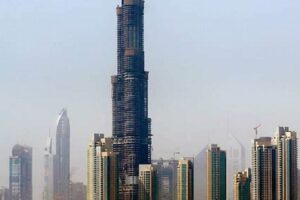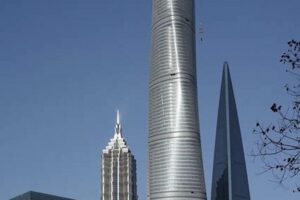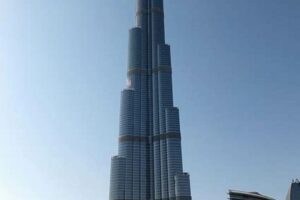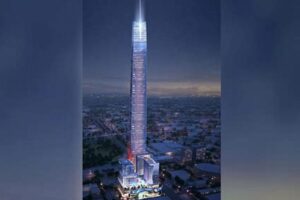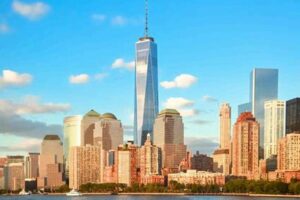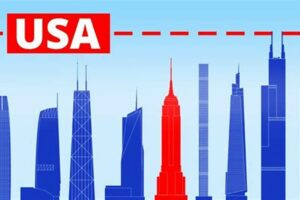World’s tallest skyscraper in Dubai refers to the Burj Khalifa, a magnificent architectural marvel that stands tall in the heart of Dubai, United Arab Emirates.
Soaring high at 828 meters (2,717 feet), the Burj Khalifa holds the prestigious title of being the tallest building in the world. Its construction, completed in 2010, was a testament to human ingenuity and engineering prowess. The skyscraper boasts an awe-inspiring design, featuring a unique Y-shaped structure that tapers towards the top. Its exterior is adorned with intricate glass and steel facades, reflecting the vibrant city below.
Beyond its remarkable height, the Burj Khalifa also offers a plethora of luxurious amenities and attractions. It houses high-end residential apartments, world-renowned hotels, elegant dining options, and state-of-the-art observation decks. The At the Top observation deck, situated on the 124th floor, provides breathtaking panoramic views of Dubai’s cityscape and the surrounding desert landscape.
The Burj Khalifa serves as a symbol of Dubai’s rapid growth and ambitious spirit. It has become a global icon, attracting tourists and business travelers alike. Its presence has significantly contributed to Dubai’s reputation as a modern and cosmopolitan city. Moreover, the construction of the Burj Khalifa has spurred economic growth and innovation within the region.
1. Height
The height of the Burj Khalifa, standing at an impressive 828 meters (2,717 feet), is a defining characteristic that sets it apart as the world’s tallest skyscraper in Dubai. This extraordinary height has far-reaching implications on various aspects, including:
- Engineering Marvel: The Burj Khalifa’s height is a testament to the advancements in engineering and architecture. Constructing a building of such immense height requires innovative techniques, specialized materials, and meticulous planning.
- Urban Planning: The skyscraper’s height has significantly influenced Dubai’s urban planning and skyline. Its towering presence has reshaped the city’s architectural landscape, making it a recognizable global landmark.
- Tourism and Observation: The Burj Khalifa’s height offers unparalleled views of Dubai and its surroundings. The observation deck, At the Top, provides visitors with a breathtaking experience, attracting tourists from around the world.
- Vertical Living: The Burj Khalifa’s height accommodates a diverse range of residential and commercial spaces, promoting vertical living and maximizing land utilization in a densely populated city like Dubai.
In conclusion, the height of 828 meters (2,717 feet) is not merely a statistic but a representation of the Burj Khalifa’s architectural prowess, urban impact, and its role in shaping Dubai’s identity as a modern metropolis.
2. Floors
The Burj Khalifa’s 163 floors are integral to its status as the world’s tallest skyscraper in Dubai. This extraordinary number of floors has profound implications on various aspects, including:
- Vertical Space Utilization: The 163 floors allow for maximum utilization of vertical space, accommodating a diverse range of functions within a single structure. This efficient use of space is crucial in a densely populated city like Dubai, where land is scarce.
- Mixed-Use Development: The Burj Khalifa’s floors are not solely dedicated to residential or commercial purposes. Instead, they house a mix of residential apartments, corporate offices, retail outlets, and hospitality venues. This mixed-use concept creates a vibrant and self-contained community within the skyscraper.
- Engineering Complexity: Constructing a building with 163 floors poses significant engineering challenges. The structure must withstand strong winds, seismic forces, and gravitational loads. The Burj Khalifa’s engineers employed innovative techniques and materials to ensure its stability and safety, making it an architectural marvel.
- Vertical Transportation: The 163 floors of the Burj Khalifa require efficient vertical transportation systems. The building is equipped with high-speed elevators that can travel at speeds of up to 10 meters per second, ensuring quick and convenient movement between floors.
In conclusion, the 163 floors of the Burj Khalifa are not merely a numerical value but a testament to its innovative design, efficient space utilization, and engineering excellence. These floors contribute to the skyscraper’s iconic status and make it a remarkable example of vertical architecture.
3. Cost
The cost of constructing the Burj Khalifa, amounting to $1.5 billion, played a pivotal role in establishing its status as the world’s tallest skyscraper in Dubai. This substantial investment reflects the ambitious vision behind the project and the intricate engineering and architectural challenges involved in its realization.
The $1.5 billion cost was meticulously allocated to various aspects of the Burj Khalifa’s construction, including:
- Innovative Design: The Burj Khalifa’s unique Y-shaped design required extensive research, modeling, and engineering expertise, significantly contributing to the overall cost.
- Specialized Materials: The skyscraper’s exterior is clad in high-performance glass and steel panels, designed to withstand extreme weather conditions and provide thermal insulation. These specialized materials added to the overall construction costs.
- Cutting-Edge Technology: The Burj Khalifa incorporates advanced construction techniques, including the use of high-strength concrete and automated construction methods. Implementing these innovative technologies required substantial investment.
- Skilled Labor: Constructing the world’s tallest skyscraper demanded a team of highly skilled engineers, architects, and construction workers. Their expertise and dedication contributed to the project’s success, but also added to the labor costs.
Understanding the connection between the $1.5 billion cost and the Burj Khalifa’s status as the world’s tallest skyscraper in Dubai highlights the significance of financial resources in achieving ambitious architectural feats. It demonstrates that innovation, advanced materials, and skilled labor come at a premium, but are essential ingredients in creating iconic structures that push the boundaries of human ingenuity.
4. Architect
The connection between “Architect: Adrian Smith” and “world’s tallest skyscraper in Dubai” is significant and multifaceted. Adrian Smith’s role as the lead architect of the Burj Khalifa, the world’s tallest skyscraper located in Dubai, underscores the crucial importance of architectural vision and expertise in shaping iconic structures.
Adrian Smith’s architectural prowess is evident in the Burj Khalifa’s innovative design, which combines functionality with aesthetics. The building’s Y-shaped floor plan provides structural stability while also maximizing views from its residential and commercial units. The exterior facade, composed of glass and steel panels, reflects the desert surroundings and creates a visually striking effect.
Beyond its architectural significance, the Burj Khalifa serves as a testament to Adrian Smith’s commitment to sustainability. The building incorporates energy-efficient features, such as double-glazed windows and a rainwater harvesting system, reducing its environmental impact. Furthermore, the mixed-use nature of the Burj Khalifa promotes vertical living, contributing to Dubai’s urban development goals.
In conclusion, the connection between “Architect: Adrian Smith” and “world’s tallest skyscraper in Dubai” highlights the invaluable role of architects in designing and constructing structures that push the boundaries of human ingenuity. Adrian Smith’s vision and expertise have resulted in a landmark that symbolizes Dubai’s rapid growth and global prominence.
5. Developer
The connection between “Developer: Emaar Properties” and “world’s tallest skyscraper in Dubai” is significant on multiple levels. Emaar Properties, a leading real estate developer in the United Arab Emirates, played a crucial role in the conception, design, and construction of the Burj Khalifa, the world’s tallest skyscraper located in Dubai.
Emaar Properties’ involvement in the Burj Khalifa project was instrumental in bringing together a team of world-renowned architects, engineers, and contractors. The company’s expertise in property development, coupled with its financial resources and commitment to innovation, ensured that the Burj Khalifa became a reality.
The Burj Khalifa’s construction involved overcoming numerous engineering challenges, including designing a structure that could withstand high winds and seismic activity. Emaar Properties’ commitment to excellence and its ability to manage complex projects were critical to addressing these challenges and delivering a building that met the highest standards of safety and quality.
In conclusion, the connection between “Developer: Emaar Properties” and “world’s tallest skyscraper in Dubai” highlights the vital role of real estate developers in shaping the skylines of modern cities. Emaar Properties’ vision, expertise, and dedication were instrumental in creating the Burj Khalifa, an iconic landmark that continues to inspire and amaze people around the world.
6. Completion
The connection between “Completion: 2010” and “world’s tallest skyscraper in Dubai” lies in the culmination of years of meticulous planning, engineering prowess, and construction efforts. The completion of the Burj Khalifa in 2010 marked a significant milestone in the history of architecture and engineering, establishing Dubai as a global hub for innovation and architectural excellence.
The Burj Khalifa’s completion in 2010 was the result of a collaborative effort involving thousands of skilled workers, engineers, and architects. The project’s success hinged upon cutting-edge construction techniques, innovative materials, and a dedicated workforce. The timely completion of the building showcased Dubai’s commitment to ambitious projects and its ability to execute them with precision and efficiency.
The completion of the Burj Khalifa in 2010 had a profound impact on Dubai’s urban landscape and global recognition. The skyscraper’s iconic design and impressive height transformed Dubai’s skyline, making it a symbol of the city’s rapid growth and economic prosperity. Furthermore, the Burj Khalifa’s completion attracted international attention and solidified Dubai’s position as a major tourist destination.
In conclusion, the connection between “Completion: 2010” and “world’s tallest skyscraper in Dubai” underscores the importance of timely execution and collaboration in achieving ambitious architectural feats. The Burj Khalifa’s completion in 2010 not only established a new benchmark for skyscrapers but also contributed to Dubai’s emergence as a global hub for innovation and architectural excellence.
7. Observation deck
The observation deck known as “At the Top” in the Burj Khalifa, the world’s tallest skyscraper in Dubai, is a prominent attraction that offers unparalleled views of the city and its surroundings. This observation deck, perched atop the 124th floor of the Burj Khalifa, provides a breathtaking experience and plays a significant role in enhancing the appeal of this iconic skyscraper.
- Panoramic Views: At the Top observation deck is renowned for its breathtaking panoramic views. Visitors can enjoy unobstructed vistas of Dubai’s glittering skyline, the Arabian Gulf, and the surrounding desert landscape. The floor-to-ceiling windows provide ample opportunities to capture stunning photographs and create lasting memories.
- Educational Experience: In addition to offering breathtaking views, the At the Top observation deck also serves as an educational experience. Interactive displays and multimedia presentations provide visitors with insights into the history, design, and construction of the Burj Khalifa. Visitors can learn about the architectural marvels and engineering feats that went into creating this iconic skyscraper.
- Tourist Attraction: The At the Top observation deck is a major tourist attraction in Dubai, attracting visitors from around the world. It offers a unique opportunity to experience the grandeur of the Burj Khalifa from a different perspective. Visitors can choose from various ticket options, including standard tickets, VIP experiences, and guided tours, to enhance their visit.
- Architectural Significance: The observation deck itself is an architectural marvel, seamlessly integrated into the design of the Burj Khalifa. The high-speed elevators whisk visitors to the top in a matter of seconds, providing a thrilling ascent to the observation deck. The deck’s design ensures unobstructed views while maintaining the structural integrity of the building.
In conclusion, the observation deck “At the Top” is an integral part of the Burj Khalifa, the world’s tallest skyscraper in Dubai. It offers breathtaking views, serves as an educational experience, attracts tourists from around the world, and showcases architectural excellence. The observation deck adds to the overall appeal of the Burj Khalifa, making it an iconic landmark and a must-visit destination for anyone visiting Dubai.
8. Hotel
Armani Hotel Dubai, an integral part of the world’s tallest skyscraper in Dubai, the Burj Khalifa, is a luxurious haven offering unparalleled experiences and amenities. This exquisite hotel seamlessly blends the world-renowned fashion brand’s elegance with the skyscraper’s architectural marvel, creating a destination that is both sophisticated and iconic.
- Unveiled Elegance: Armani Hotel Dubai embodies the sophisticated style of renowned fashion designer Giorgio Armani, featuring sleek interiors, exquisite furnishings, and a neutral color palette accented by signature Armani fabrics and patterns. The hotel’s design reflects a harmonious fusion of fashion and architecture, creating a visually captivating space.
- Exceptional Accommodations: The hotel offers 160 elegantly appointed guest rooms and suites, ranging from the Deluxe Room to the two-bedroom Armani Suite, each providing breathtaking views of Dubai’s skyline or the Arabian Gulf. Guests can indulge in the ultimate luxury, surrounded by plush amenities, state-of-the-art technology, and personalized butler service.
- Culinary Delights: Armani Hotel Dubai is home to an array of world-class dining venues, offering a culinary journey that tantalizes the taste buds. From authentic Italian cuisine at Armani/Ristorante to contemporary Indian flavors at Armani/Amal, each restaurant presents a unique gastronomic experience curated by renowned chefs. Guests can also enjoy light bites and refreshments at the Armani/Lounge or indulge in handcrafted cocktails at the Armani/Priv.
- Unrivaled Amenities: The hotel features a comprehensive range of amenities designed to cater to every need and desire. Guests can rejuvenate in the world-renowned Armani/Spa, featuring rejuvenating treatments and therapies. The hotel also offers a state-of-the-art fitness center, a stunning outdoor pool, and exclusive access to the Burj Khalifa’s observation deck, providing unparalleled views of the city.
In conclusion, the connection between “Hotel: Armani Hotel Dubai” and “world’s tallest skyscraper in Dubai” lies in the seamless integration of luxury, fashion, and architectural brilliance. Armani Hotel Dubai is not merely a hotel within a skyscraper; it is an experience that complements and enhances the iconic status of the Burj Khalifa, offering guests an unforgettable stay in the heart of Dubai’s vibrant metropolis.
9. Residential apartments
The presence of over 900 residential apartments within the Burj Khalifa, the world’s tallest skyscraper in Dubai, establishes a unique connection between luxurious living and architectural marvel. These apartments offer an exclusive lifestyle, unparalleled views, and access to world-class amenities, making them highly sought-after residences in the heart of Dubai’s bustling metropolis.
- Unparalleled Views: Residents of the Burj Khalifa’s apartments enjoy breathtaking panoramic views of Dubai’s skyline, the Arabian Gulf, and the surrounding desert landscape. The floor-to-ceiling windows provide ample natural light and create a sense of spaciousness, allowing residents to fully immerse themselves in the city’s vibrant atmosphere.
- Exclusive Amenities: Residents have access to an array of exclusive amenities designed to enhance their living experience. These include a state-of-the-art fitness center, a stunning outdoor pool, and access to the Burj Khalifa’s observation deck, providing unparalleled views of the city from a different perspective.
- Height and Prestige: Living in one of the world’s tallest buildings carries a sense of prestige and exclusivity. Residents can proudly call the Burj Khalifa their home, a symbol of Dubai’s architectural prowess and a testament to their discerning taste.
- Investment Potential: The residential apartments in the Burj Khalifa are considered valuable real estate investments due to their prime location, high demand, and potential for rental income. Investors can capitalize on the continuous growth of Dubai’s property market and enjoy a lucrative return on their investment.
In conclusion, the connection between “Residential apartments: 900+” and “world’s tallest skyscraper in Dubai” highlights the unique opportunity to reside in an architectural masterpiece while enjoying the highest standards of luxury and convenience. These apartments offer an exclusive lifestyle, unparalleled views, access to world-class amenities, and the prestige of living in one of the most iconic buildings in the world.
Frequently Asked Questions about the World’s Tallest Skyscraper in Dubai
This section addresses common inquiries and misconceptions surrounding the Burj Khalifa, the world’s tallest skyscraper located in Dubai, United Arab Emirates. These questions and answers provide concise and informative insights into various aspects of this architectural marvel.
Question 1: What is the height of the Burj Khalifa?
The Burj Khalifa stands at an impressive height of 828 meters (2,717 feet), making it the tallest structure ever constructed by humans.
Question 2: How many floors does the Burj Khalifa have?
The Burj Khalifa has a total of 163 floors, accommodating a diverse range of residential apartments, corporate offices, retail outlets, and hospitality venues.
Question 3: How long did it take to construct the Burj Khalifa?
The construction of the Burj Khalifa was a remarkable feat of engineering and took approximately six years, beginning in 2004 and concluding in 2010.
Question 4: What is the cost of the Burj Khalifa?
The total cost of constructing the Burj Khalifa is estimated to be around $1.5 billion, reflecting the complexity of its design and the use of advanced materials and construction techniques.
Question 5: Is the Burj Khalifa earthquake-proof?
Yes, the Burj Khalifa is designed to withstand earthquakes and other seismic activity. It incorporates advanced engineering techniques and materials to ensure its stability even during extreme events.
Question 6: Can tourists visit the Burj Khalifa?
Yes, the Burj Khalifa is open to tourists who can purchase tickets to visit the observation deck, known as “At the Top,” which offers breathtaking panoramic views of Dubai from the 124th floor.
Summary: The Burj Khalifa stands as a testament to human ingenuity and engineering prowess. Its exceptional height, numerous floors, and earthquake-resistant design make it a marvel of modern architecture. While tourists can visit the observation deck for breathtaking views, the building also houses a variety of residential and commercial spaces, making it a vibrant hub within Dubai’s skyline.
Transition to the next article section: To delve deeper into the architectural wonders of Dubai, let’s explore other iconic skyscrapers that contribute to the city’s remarkable skyline.
Tips for Visiting the World’s Tallest Skyscraper in Dubai
Visiting the Burj Khalifa, the world’s tallest skyscraper located in Dubai, is an awe-inspiring experience. To make the most of your visit, consider the following tips:
Book your tickets in advance: As one of Dubai’s most popular tourist destinations, the Burj Khalifa attracts a large number of visitors. Booking your tickets online in advance helps secure your spot and avoids potential wait times.
Arrive early: To fully immerse yourself in the experience and avoid crowds, plan to arrive at the Burj Khalifa early. This allows ample time to check in, go through security, and make your way to the observation deck.
Choose the right time to visit: The Burj Khalifa offers breathtaking views during both day and night. Consider visiting around sunset to witness the city transform from daylight to a glittering metropolis.
Capture the moment: Don’t forget your camera to capture the stunning panoramic views from the observation deck. Remember to respect other visitors and follow any photography guidelines.
Explore the surrounding area: The Burj Khalifa is situated in the heart of Dubai’s vibrant downtown district. Take some time to explore the surrounding area, which offers a variety of shopping, dining, and entertainment options.
Consider a guided tour: For a more in-depth experience, consider booking a guided tour of the Burj Khalifa. Guided tours provide insights into the building’s history, architecture, and engineering marvels.
Summary: By following these tips, you can enhance your visit to the Burj Khalifa, ensuring a memorable and awe-inspiring experience. From booking your tickets in advance to exploring the surrounding area, every aspect of your visit can be optimized to create lasting memories.
Transition to article conclusion: As you embark on your journey to the world’s tallest skyscraper, remember to embrace the breathtaking views, appreciate the architectural marvel, and cherish the unforgettable moments that await you at the Burj Khalifa.
Conclusion
The exploration of the “world’s tallest skyscraper in Dubai” has unveiled the remarkable architectural achievement of the Burj Khalifa. Its exceptional height, innovative design, and luxurious amenities have solidified its status as a global icon and a symbol of Dubai’s rapid growth.
Beyond its physical attributes, the Burj Khalifa serves as a reminder of human ingenuity and the pursuit of architectural excellence. It stands as a testament to the visionaries, engineers, and countless individuals who brought this marvel to life. As a beacon of innovation, the Burj Khalifa continues to inspire and captivate visitors from around the world, solidifying Dubai’s position as a city of architectural wonders and limitless possibilities.


